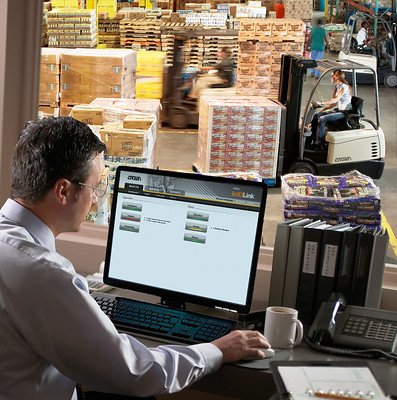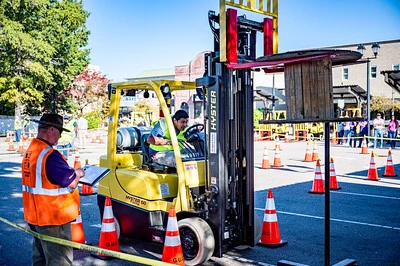Is Forklift Training Hard? (Is It Easy to Learn?)
January 23, 2024 | by Mike Pattenson


Forklift training can be challenging for some people, but it’s not usually too hard and it is easy to learn. It involves learning how to operate the forklift safely, understanding the controls, and knowing how to handle loads properly. The training also includes important safety rules. While it might take a bit of practice to get comfortable with driving a forklift, most people can learn it with proper training and some practice.
After getting the basics down, the next part is practicing and becoming skilled at using the forklift. This includes learning how to move and lift objects correctly, how to navigate in tight spaces, and how to keep both the forklift and the load stable. Safety is a big part of the training too, so you’ll learn how to operate the forklift without causing accidents or injuries.
While forklift training requires focus and practice, especially when it comes to safety and handling, it’s generally manageable for most people. With a good instructor and a willingness to learn, you can become skilled at operating a forklift.
Forklift Is Easy to Learn
Learning to use a forklift isn’t super easy, but it’s not too hard either. It’s like learning a new skill – it takes some effort, but most people can do it with the right training and practice. Just remember to be safe while you’re learning, and it will get easier as you go along.
Think of it like this: learning to operate a forklift is a bit like learning to ride a bike. It might feel tricky at first, but once you get the hang of it, it becomes second nature. So, while it’s not a walk in the park, it’s doable with some effort and practice.
Imagine learning to use a forklift as similar to learning how to drive a car. It’s not as easy as tying your shoelaces, but it’s also not like solving a super-hard puzzle. With the right training and practice, it’s something most people can get the hang of. Just take it step by step, stay safe, and over time, it’ll become more and more comfortable.
if you do not have time to take the training in person, you may opt to take the online course.
Overview of The Training
Forklift training is about learning how to use a forklift. It includes classroom lessons where you learn the rules and how forklifts work. Then, you practice driving the forklift and moving things with it. You also learn how to be safe so no one gets hurt. In the end, you need to pass a test to show you can use a forklift properly.
After you learn the basics in the classroom, you get to actually drive the forklift. This is where you practice picking up and moving stuff, turning, and driving in different places, like tight spaces. The training makes sure you know how to do all this without dropping anything or causing any accidents.
Safety is really important in forklift training. You learn about wearing the right gear, like a helmet, and following rules to keep everyone safe. The training also teaches you what to do in case something goes wrong.
Finally, when you’ve learned everything and practiced enough, you take a test. If you pass this test, you get a certificate that says you know how to use a forklift safely and correctly. This is important because it shows your boss or anyone else that you’re trained and ready to handle a forklift at work.
If you fail the test, you can still retake it, just ask the trainer when are going to retake it.
Some Challenges You Need To Be Aware Of
In forklift training, there are a few tough parts. First, you have to learn all the buttons and levers on the forklift – that’s the technical stuff. It can be tricky to remember what each one does.
Then, there’s learning how to drive the forklift and move it around, especially in tight spots or when turning. It’s not like driving a car, so it takes some getting used to.
Another challenge is learning how to pick up and carry things without dropping them. You need to know how to balance the load so it’s safe.
Also, being aware of everything around you – like people, walls, and other stuff – is really important. This is called spatial awareness. You have to be careful not to bump into anything.
Lastly, different forklifts can be a bit different to drive. So, if you learn about one type, another type might feel a bit strange at first. You need to practice to get good at each kind.
As you keep practicing, you’ll find that each forklift has its own feel. Some might be faster, turn differently, or lift things differently. It’s like getting to know different cars – each one is a bit unique.
Learning how to see everything around you while you’re driving the forklift is also something you get better at over time. It’s like needing to have eyes in the back of your head, so you don’t hit anything or anyone.
And sometimes, the things you need to lift and move can be really heavy or awkwardly shaped. Figuring out the best way to pick them up and move them without tipping over or dropping them is a big part of what you learn.
So, while these challenges can make forklift training a bit tough at first, with practice and attention, taking the forklift training is not hard, most people get the hang of it. It’s all about learning step by step and getting more comfortable each time you use the forklift.
Safety Considerations To Take Note Of
Safety is super important when using a forklift. It’s the number one thing to think about. There are a lot of rules you have to follow to make sure you and everyone around you are safe. These rules tell you things like how to drive safely, how to lift things without causing accidents, and what safety gear to wear.
These safety rules can seem complicated at first. There’s a lot to remember, like speed limits, where you can and can’t drive the forklift, and how to check if the forklift is safe to use.
The thing is, the more you understand these safety rules, the easier it gets to use the forklift. At first, it might feel like a lot to think about, but once you get used to following these rules, they just become a normal part of how you use the forklift.
Staying safe means you’re less likely to have accidents or hurt yourself or others. This makes using the forklift less stressful because you know you’re doing things the right way. It’s all about learning these rules well and always keeping them in mind.
Personal Attributes and Learning Styles
Let’s talk about how each person is different and how that affects learning to use a forklift.
Some folks might have done similar stuff before, like driving a car or using machines. This can make forklift training easier because they’re used to some of the basic skills.
People also learn in different ways. Some like to read and listen, while others like to practice hands-on. This means that how you learn can affect how easy or hard forklift training feels.
Another thing is physical abilities. Being able to adapt quickly, coordinate your movements, and pay attention to details can make learning easier. These skills help you handle the forklift better and stay safe.
So, everyone’s a bit different, and these differences can make forklift training feel easier or harder depending on your background and how you like to learn.
If you’ve had experience with things like driving or using machines, it can give you a head start in forklift training. It’s a bit like having some puzzle pieces already in place.
Now, when it comes to how you learn, some people like to read and listen to instructions, while others prefer getting their hands dirty and practicing. Your style of learning can affect how quickly you pick up forklift skills.
Also, your physical abilities play a role. Being adaptable, having good coordination, and paying attention to small details can make learning smoother. It’s like having the right tools for the job.
So, your previous experiences, how you like to learn, and your physical skills can all impact how easy or tough forklift training seems to you. It’s about finding your own path to mastering it.
Conclusion
In summary, the question ‘Is forklift training hard?’ is one that many individuals contemplating forklift training may ask. While forklift training is not exceptionally hard, it does require effort, practice, and a strong commitment to safety. Learning to operate a forklift is akin to acquiring a new skill set, and success often depends on individual attributes, prior experiences, and preferred learning styles.
It’s important to recognize that with proper training and dedication, mastering forklift operation is achievable. As you embark on this journey, remember that while it may not be a breeze, it’s definitely within reach for those who prioritize learning and safety.
Forklift training may not be a walk in the park, but it’s also not an insurmountable challenge. Learning to operate a forklift can be compared to acquiring a new skill – it takes effort, practice, and a focus on safety.
While individual experiences and backgrounds may vary, with the right training and a willingness to learn, most individuals can become proficient forklift operators. It’s essential to consider personal attributes, previous experience, and learning styles, as they can influence the learning process.
Just like riding a bike or driving a car, forklift operation becomes more comfortable with time and practice. So, while it may not be exceptionally easy, it’s certainly attainable for those who put in the effort and follow safety guidelines.
RELATED POSTS
View all



